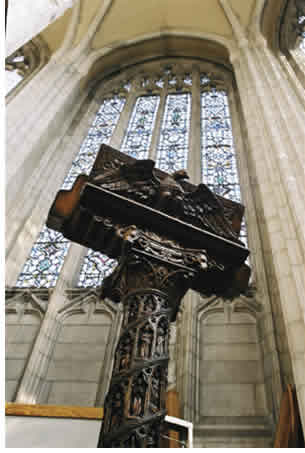This ornately carved walnut lectern – a gift to Trinity College from an anonymous donor in 1953 – once served as the college chapel’s centrepiece. But in the early 1990s, the object was shuffled off to a storage room, where it waited among music stands, mops and folding chairs to be rediscovered. That wait ended in 2000, when Trinity student Eleanor Pachaud spotted it and, two years later, researched its provenance for a medieval art-history class.“It’s medieval in spirit,” says Pachaud (BA 2004 Trinity),who is close to completing a master’s degree in medieval studies. “That’s why it fascinated me.”
The shaft of the lectern is engraved with tiny praying figures, about half of which Pachaud identified as saints. Carvings on the base depict the evangelists Matthew, Mark, Luke and John. Dating the lectern is problematic, as the shaft and base appear to have been made separately and joined later. But Pachaud believes it can be traced to 16th-century Germany, given its similarity to other pieces of that time and place.
While the lectern’s pedigree is uncertain, its enduring popularity is clear: many of the wooden saints are worn smooth from centuries of being touched by devotional visitors.“It’s very much like a rosary, in the sense of walking around it and touching it,” says Pachaud. “It’s more of a devotional tool, a piece of folk art. It’s not high art; it’s more of a curiosity.” Curious visitors today can see the lectern on display at the John M.Kelly Library at the University of St. Michael’s College, without a mop or a folding chair in sight.
Recent Posts
U of T’s Feminist Sports Club Is Here to Bend the Rules
The group invites non-athletes to try their hand at games like dodgeball and basketball in a fun – and distinctly supportive – atmosphere
From Mental Health Studies to Michelin Guide
U of T Scarborough alum Ambica Jain’s unexpected path to restaurant success
A Blueprint for Global Prosperity
Researchers across U of T are banding together to help the United Nations meet its 17 sustainable development goals






